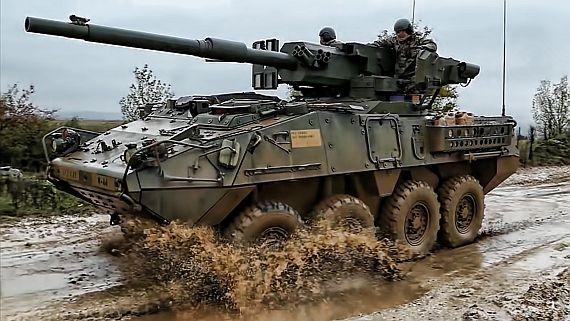Global Military Vetronics Market Growth, Demand, Opportunity, Scope and Forecast to 2028
Military Vetronics Market research study's objective is to provide statistical information about the industry's sales forecast, CAGR, driving factors, difficulties, product categories, application scope, and competitive environment.
The Military Vetronics Industry Research report includes a thorough analysis of industry growth prospects, market size and value, and prevailing commercial trends. This investigation looked into the demand for Military Vetronics from several angles. This research report examines the various factors that have influenced the growth of the Military Vetronics Market. The Military Vetronics market study provides a thorough overview of global technological developments and trends. Based on volume, performance, and valuation, the Military Vetronics market study determines the precise market share. To forecast and estimate the size of the global market, top-down and bottom-up methods are used.
Major key Players Included in this report are as follows
Lockheed Martin Corporation, Ultra Electronics Ltd., Elbit Systems Ltd., Kongsberg Gruppen ASA, The Curtiss-Wright Corporation, General Electric Company, The Raytheon Company, BAE Systems PLC, General Dynamics Corporation, SAAB A.B., Thales Group
Impact of COVID-19
1. The data shows that Coronavirus (COVID-19) has an impact on the business of the Military Vetronics Market.
2. Since the COVID-19 viral outbreak in December 2021, the illness has spread to nearly 180 countries, causing the World Health Organization to declare it a public health emergency.
3. The Military Vetronics Market will be significantly influenced by the coronavirus infection 2021 (COVID-19), the impacts of which are already being seen on a global scale.
4. The COVID-19 epidemic has resulted in restaurant closures, travel bans, quarantines, flight cancellations, travel bans, and restrictions on all indoor activities.
5. An emergency has been declared in various nations. Massive supply chain inefficiency, volatile financial markets, declining business confidence, growing public panic, and future apprehension.
Three significant impacts of COVID-19 on the world economy are possible: a direct influence on supply and demand, market and supply chain disruption, and a financial impact on businesses and financial markets.
Key features of Military Vetronics Market:
1. Along with being recognized, the raw material providers' market concentration rates have been as well.
2. The study lists the production cost structures, which comprise data on raw materials, an examination of the manufacturing process, and labor costs.
3. In-depth explanations of the industrial chain analysis, downstream purchasers, and sourcing strategies have all been provided.
4. A portion has been set aside for the analysis of the employed marketing strategy and data on the supply chain's wholesalers.
5. The cost analysis, primary raw materials used, and the volatile pricing trends of the war materials are all included in the Military Vetronics Market Market report.
6. The study provides information on the target market, price and brand strategies, marketing channel development trends, and the employed product marketing channels.
The report covers an exhaustive analysis on:
- Market Segments Military Vetronics
- Market Dynamics Military Vetronics
- Market Size, Supply, and Demand (Military Vetronics)
- Current Issues/Challenges/Trends
- Value Chain Competition and Companies Involved
Global Military Vetronics Market is further classified on the basis of region as follows:
North America (United States, Canada), Market size, Y-O-Y Growth Market size, Y-O-Y growth & Opportunity Analysis, Future forecast & Opportunity Analysis
Latin America (Brazil, Mexico, Argentina, Rest of LATAM), Market size, Y-O-Y growth, Future forecast & Opportunity Analysis
Europe (U.K., Germany, France, Italy, Spain, Hungary, BENELUX (Belgium, Netherlands, Luxembourg), NORDIC (Norway, Denmark, Sweden, Finland), Poland, Russia, Rest of Europe), Market size, Y-O-Y growth, Future forecast & Opportunity Analysis
Asia-Pacific (China, India, Japan, South Korea, Malaysia, Indonesia, Taiwan, Hong Kong, Australia, New Zealand, Rest of Asia-Pacific), Market size, Y-O-Y growth, Future forecast & Opportunity Analysis
the Middle East and Africa (Israel, GCC (Saudi Arabia, UAE, Bahrain, Kuwait, Qatar, Oman), North Africa, South Africa, Rest of the Middle East and Africa), Market size, Y-O-Y growth, Future forecast & Opportunity Analysis
There are 15 Chapters to display the Global Military Vetronics market
Chapter 1, Definition, Specifications, and Classification of Military Vetronics, Application, and
- Light Protected Vehicles
- Special Purpose Vehicles
- Unmanned Ground Vehicles
- Armored Amphibious Vehicles
Chapter 2, Manufacturing Cost Structure, Raw Materials and Suppliers, Manufacturing Process, and Industry Chain Structure are all examples of manufacturing cost structures.
Chapter 3, Military Vetronics Technical Data and Manufacturing Plants Analysis, Capacity and Commercial Production Date, Manufacturing Plants Distribution, R&D Status, and Technology Source, Raw Materials Sources Analysis
Chapter 4, Overall Market Analysis, Company Segment Capacity Analysis, Company Segment Sales Analysis, and Company Segment Sales Price Analysis;
Chapters 5 and 6, Military Vetronics Segment Market Analysis (by Type), which covers the United States, China, Europe, Japan, Korea, and Taiwan.
Chapters 7 and 8, Market Segment Analysis by Military Vetronics (by Application) Analysis of Military Vetronics by Major Manufacturers
Chapter 9, Market Trend Analysis, Regional Market Trends, and Product Type Market Trends Product and
- Communication System
- Power System
- Navigation System
- Control & Data Distribution System
- C4 System
- Display System
Chapter 10, Regional marketing type analysis, international trade type analysis, and supply chain analysis are all examples of regional marketing type analysis.
Chapter 11, Consumers' Research on Global Military Vetronics;
Chapter 12, Military Vetronics Findings and Conclusions, Appendix, Methodology, and Data Source
Chapters 13, 14, and 15, Military Vetronics: sales channel, distributors, traders, dealers, Research Findings and Conclusions, appendix, and data source
Read More Articles -
Precision Medicine Software Market Size, Share, Global Trends, Forecast to 2028
Global Waterborne Coatings Market Size, Share, Growth Analysis, Forecast Report 2022-2028
Gene Therapy Market Size, Share, Global Trends, Forecast to 2028
Global ERP Software Market Size, Share, Growth Analysis Report 2022-2028
Enzymes Market Size, Share, Global Trends, Forecast to 2028
Global Satellite Market Size, Share, Growth Analysis, Forecast Report 2022-2028
Global Fuel Cell Market Trends, Future Scope, Forecast 2028
Global Offshore Support Vessels Supply Base (OSB) Market Size, Growth, Segments and Forecast to 2028
Global Biomass Pellets Market Growth Rate, Recent Developments and Top Players
Global Carbon Black Market Size, Growth Share, Overview, Forecast and Regional Analysis 2028
Global Steam Turbine For Power Generation Market Size, Share, Growth, Trends and Forecasts 2022-2028
Global Steel Powder Market Size, Share and Trend Analysis 2022-2028
Global Internet of Things (IoT) in Energy Market Growth, Trends, And Forecasts 2022-2028
Contact Us:
Facts & Factors
A 2108, Sargam,
Nanded City,
Sinhagad Road,
Pune 411041, India
USA: +1-347-989-3985
Email: sales@fnfresearch.com
Web: https://www.fnfresearch.com



Comments
Post a Comment